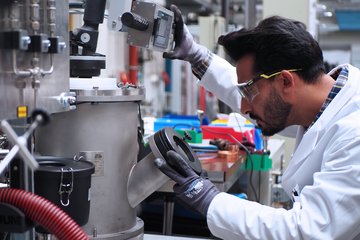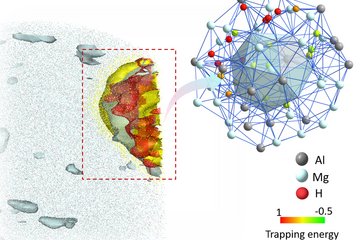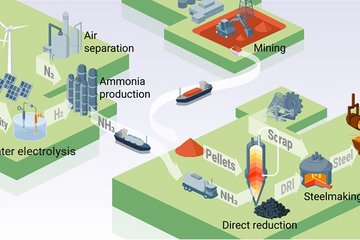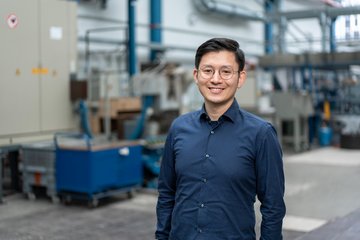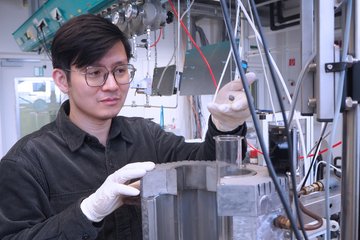Alle Typen
1441.
Vortrag
Robust spectral-based numerical methods for heterogeneous microstructures. 4th International Symposium on Computational Mechanics of Polycrystals, CMCn2014, Düsseldorf, Germany (2014)
1442.
Vortrag
Robust spectral-based numerical methods for heterogeneous microstructures. 24th International Workshop on Computational Micromechanics of Materials, IWCMM24, Madrid, Spain (2014)
1443.
Vortrag
Tailoring multi-phase microstructures by control of local chemical gradients, applied to austenite in martensitic steel. Icomat 2014
, Bilbao, Spain (2014)
1444.
Vortrag
Recent Advances in Understanding the Structures and Properties of Nanomaterials. Gordon Research Conference on Structural Nanomaterials, The Chinese University of Hong Kong, Hong Kong, China (2014)
1445.
Vortrag
Characterization of internal interfaces in Cu(In,Ga)Se2 thin-film solar cells using correlative microscopies. 40th PVSC IEEE 2014, Denver, CO, USA (2014)
1446.
Vortrag
Synthetic dental composite materials inspired by shark teeth. Annual Meeting of the Canadian Biomaterials Society, Halifax, Nova Scotia, Canada (2014)
1447.
Vortrag
Recent development of modelling techniques in nano- and meso-scale simulations of dislocation dynamics. Workshop on Integrated Computational Materials Engineering (ICME), Rolduc Abbey, The Netherlands (2014)
1448.
Vortrag
Accelerated nucleation in nanocrystalline Fe–Si–Nb–B soft-magnetic alloy. ISMANAM 2013, 20th International Symposium on Metastable, Amorphous and Nanostructured Materials, Turin, Italy (2014)
1449.
Vortrag
Modelling of dislocation propagation during creep of single crystal Ni-base superalloys. Eurosuperalloys 2014, Giens, France (2014)
1450.
Vortrag
High temperature coevaporation of Cu2ZnSnSe4. E-MRS Spring Meeting 2014, Lille, France (2014)
1451.
Vortrag
3-Dimensional Microstructural and Crystallographic Characterization of CdTe Absorber Layers from CdTe/CdS Solar Cells Grown in Substrate Configuration. E-MRS, European Materials Research Society Conference 2014
, Lille, France (2014)
1452.
Vortrag
Integrated experimental and simulation analysis of stress and strain partitioning in dual phase steel. IUTAM Symposium on Connecting Multiscale Mechanics to Complex Material Design, Evanston, IL, USA (2014)
1453.
Vortrag
Mesoscale modelling of the influence of loading conditions on the dislocation mobility and creep process in single crystal Ni base superalloys. KTH Stockholm-Sweden, Stockholm, Sweden (2014)
1454.
Vortrag
Nanostructure Manipulation by Segregation Engineering. George Smith Symposium on Atom Probe Tomography, Oxford, UK (2014)
1455.
Vortrag
Glass vs. crystal: Element-resolved corrosion analysis of gradually devitrified Fe-based alloys. Talk at University of Göttingen, Göttingen, Germany (2014)
1456.
Vortrag
Fossilized shark teeth versus their recent counterparts: An in-depth comparison. DGM Bio-inspired Materials: International Conference on Biological Material Science, Potsdam, Germany (2014)
1457.
Vortrag
Synthetic dental composite materials inspired by the hierarchical organization of shark tooth enameloid. Third winter school within the DFG priority programme 1420 "Biomimetic Materials Research: Functionality by Hierarchical Structuring of Materials", Potsdam, Germany (2014)
1458.
Vortrag
Atom Probe Tomography and Correlative TEM/APT at the MPIE. Inauguration of the Atom Probe at the Institute for Physics IA at the RWTH Aachen, Aachen, Germany (2014)
1459.
Vortrag
Nanostructure Manipulation by Segregation Engineering. 2nd ESISM International Workshop on Fundamental Issues of Structural Materials, Kyoto, Japan (2014)
1460.
Vortrag
Coupled experimental-numerical Analysis of Microstructures. DGM Arbeitskreissitzung Mikrostrukturmechanik, Freiberg, Germany (2014)
